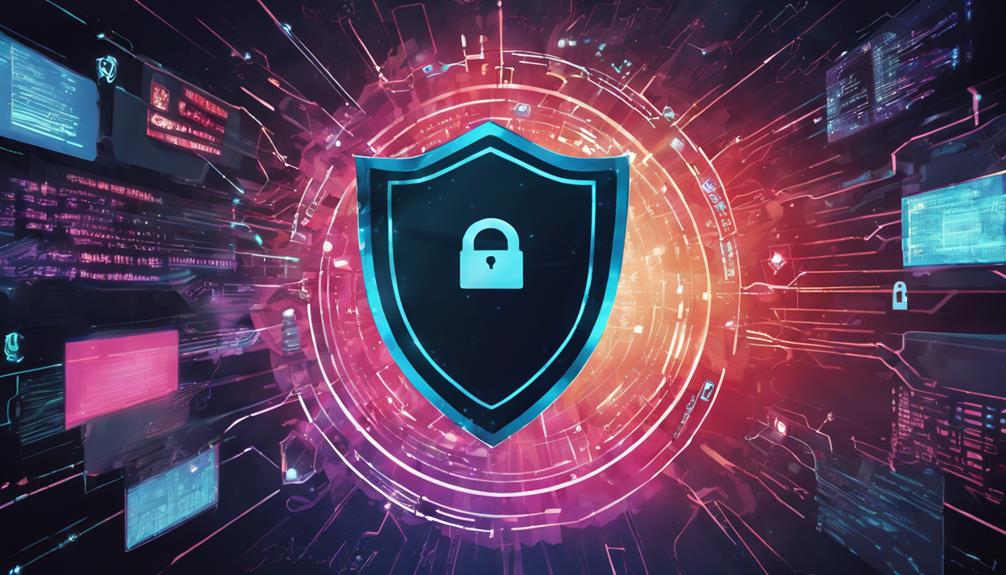Discover how crowdsourced hackers through bug bounty programs help Fortune 500s find vulnerabilities fast, saving millions in cybersecurity costs and boosting defenses. These programs leverage diverse hacker expertise to uncover critical flaws early, reduce risks, and improve overall security posture. Incentives like cash rewards motivate ongoing participation, while global growth and evolving strategies keep these initiatives effective. To understand how these programs continually transform enterprise security, keep exploring the details that make this approach so powerful.
Key Takeaways
- Crowdsourced hackers identify vulnerabilities faster and more cost-effectively than traditional security teams, saving Fortune 500 companies millions.
- Bug bounty programs incentivize external researchers with monetary rewards, reducing the risk of costly security breaches.
- The cost savings from bug bounties can reach approximately $552,000 over three years compared to internal testing.
- Large companies leverage bug bounty programs to proactively discover and patch vulnerabilities before exploitation.
- Managed bug bounty programs enhance security efficiency, lowering overall cybersecurity expenses for Fortune 500 organizations.
Growing Adoption of Bug Bounty Programs Among Large Enterprises

The adoption of bug bounty programs among large enterprises has seen rapid growth in recent years. By 2023, 63% of Fortune 500 companies had embraced these programs, up from 50% in 2020. Governments like the U.S. Department of Defense are also involved, with initiatives such as “Hack the Pentagon” resolving over 40,000 vulnerabilities. Projections suggest that by 2025, around 80% of organizations will adopt bug bounty programs. Large tech firms have awarded over USD 100 million in bounties, demonstrating significant financial commitment. Enterprises with over 5,000 employees account for 16.3% of all programs, reflecting a strong shift toward crowdsourced security. This trend is driven by the rising frequency of cyberattacks, regulatory pressures, and the expansion of cloud computing and IoT devices. Growing cybersecurity workforce is also a key factor, as more skilled professionals are participating in bug bounty initiatives to meet increasing security demands. Additionally, fostering a culture of creative problem-solving can help organizations develop innovative security solutions beyond traditional methods.
Industry Sectors Leading the Way in Crowdsourced Security

You’ll notice that the tech industry leads crowdsourced security efforts, with giants like Microsoft and Google running extensive bug bounty programs. The financial sector also takes a prominent role, driven by high-value data and increasing regulations, while other industries still have gaps to close. Understanding these sector priorities helps clarify where crowdsourced security is making the biggest impact—and where it still needs to grow. Additionally, sectors focusing on vetted security products are more likely to implement comprehensive bug bounty initiatives to protect sensitive information.
Tech Industry Dominance
Tech companies are leading the charge in crowdsourced security by implementing robust bug bounty programs across their core sectors. Google’s long-standing initiative covers platforms like Google and YouTube, offering rewards up to $31,337 for critical issues. Apple targets vulnerabilities on iOS, macOS, and related OSes, with bounties reaching $250,000 for severe risks. Intel focuses on firmware, hardware, and software flaws, paying between $500 and $30,000. Microsoft’s expansive program offers up to $300,000 for Azure cloud vulnerabilities and $30,000 for Windows issues. Facebook maintains active programs to protect its massive social media infrastructure, offering a minimum payout of $500. These giants leverage top platforms like Bugcrowd, Intigriti, and YesWeHack, driving innovation and strengthening security across the tech landscape. Crowdsourcing initiatives have become a vital part of modern cybersecurity strategies, harnessing the expertise of independent researchers worldwide. Additionally, the integration of security technology such as automated vulnerability scanning enhances the effectiveness of these programs.
Financial Sector Adoption
Have you noticed how rapidly the financial sector is embracing crowdsourced security through bug bounty programs? Over the past three years, application security programs in finance have grown by 400%, making it the third-largest industry adopting these initiatives. Most programs are private—around 60%—highlighting the sector’s focus on sensitive data and risk management. The average payout per vulnerability is $323, higher than other industries, reflecting the high stakes involved. With web application attacks skyrocketing to 82%, financial firms are turning to bug bounties alongside traditional testing to combat sophisticated threats like phishing, ransomware, and DDoS. North America leads the charge, with Asia Pacific and Europe rapidly expanding. This shift enhances vulnerability detection, cost-effectiveness, and trust, positioning the financial sector as a trailblazer in crowdsourced cybersecurity enhancing security posture.
Non-Tech Sector Gaps
As industries outside of technology recognize the increasing cyber threats, many are turning to crowdsourced security to fill critical gaps. Public sector agencies and governments are launching bug bounty programs to protect sensitive citizen data and critical infrastructure. Initiatives like the U.S. Department of Defense’s “Hack the Pentagon” have uncovered over 40,000 vulnerabilities, encouraging broader adoption across agencies. In healthcare, bug bounties help secure patient records, medical devices, and telehealth platforms from emerging threats, ensuring compliance with privacy laws like HIPAA. Retailers utilize bug bounties to safeguard payment systems and e-commerce sites against data breaches amid rising online shopping. Industrial sectors leverage crowdsourced security to identify vulnerabilities in IoT devices and manufacturing systems, reducing risks of costly disruptions and enhancing overall safety. This trend demonstrates the expanding role of bug bounty programs across various sectors, highlighting their importance beyond traditional tech environments.
Structuring Incentives: Rewards and Motivations for Hackers

You’ll find that the way rewards are structured markedly impacts hacker motivation, especially when critical vulnerabilities command payouts of millions. As payouts increase and transparency improves, hackers are more driven to participate actively and report high-severity issues. Understanding these incentives helps organizations design programs that attract and retain skilled security researchers. A well-structured program also considers emotional support, recognizing the importance of addressing participants’ confidence and trust in the process. Response efficiency metrics, such as average response times and percentage meeting targets, also play a crucial role in fostering trust and engagement among hackers by demonstrating the program’s responsiveness and operational effectiveness.
Reward Structures and Severity
Reward structures in bug bounty programs are carefully designed to motivate researchers by aligning payouts with the severity of discovered vulnerabilities. You’re encouraged to focus on critical flaws, as payouts escalate from low ($100–$500) to high severity. Bonus incentives, like Meta’s Hacker Plus, add up to 30% extra, rewarding exceptional findings. Severity classification guides payouts and prioritization, with higher-impact bugs earning larger rewards. Here’s a snapshot:
| Severity Level | Typical Reward Range |
|---|---|
| Low | $100–$500 |
| Medium | $500–$2,000 |
| High | $2,000 and above |
| Critical | Maximize impact, top payouts |
This structure motivates detailed research, ensuring critical vulnerabilities get the attention they deserve. Additionally, severity classification helps organizations prioritize remediation efforts effectively and encourages researchers to focus on impactful issues. Recognizing the importance of proper reward structuring can lead to more comprehensive vulnerability discoveries and stronger overall security.
Motivational Factors for Hackers
Hackers are motivated by a mix of factors that go beyond just monetary rewards. Recognition and reputation-building are vital, especially for newcomers seeking exposure and career growth. Many see bug bounty programs as a pathway to a cybersecurity career, with 79% aiming to learn and 59% pursuing advancement. Skill development and challenge are key drivers, with earnings often reinvested into tools and training. While about 76% are financially motivated, the structure of payouts influences participation—quick payments, large rewards, or easy targets appeal to different hackers. Altruism also plays a role, as many hackers want to improve security for the greater good. Community, recognition, and the desire to stay ahead technically further fuel their motivation, creating a dynamic ecosystem of continuous learning and contribution.
Economic Benefits: Cost Savings and Risk Mitigation

Implementing bug bounty programs can lead to significant cost savings and enhanced risk mitigation for organizations. You save roughly $552,000 over three years compared to traditional pen tests, and annual internal security costs average $456,000, while bug bounties run around $84,000. Managed programs can deliver risk-adjusted benefits of $2.3 million in the same period, reducing breach risks and improving security. Prior security testing can cut expenses from $25,000 to $1,000 in six months. Plus, bug bounties free up your security team for strategic tasks, avoiding extra hires. Identifying vulnerabilities through bug bounty programs is a crucial step in maintaining robust security.
Challenges in Implementing and Managing Bug Bounty Initiatives

Managing bug bounty programs is challenging because you must efficiently filter and verify reports to focus on genuine, high-severity issues. Balancing incentives is also tricky, as increasing rewards can attract more hunters but may dilute motivation and lead to lower-quality submissions. Without careful scope definition and transparent communication, maintaining researcher engagement and program integrity becomes even more difficult. Additionally, implementing effective validation processes is essential to prevent false positives and ensure that reported vulnerabilities are accurately assessed. Employing track development techniques can help structure reports more effectively, streamlining the verification process.
Triage and Validation Complexities
Triage and validation are among the most complex challenges in bug bounty programs, as the sheer volume of vulnerability reports can quickly become overwhelming. You must filter out duplicates and invalid submissions to maintain quality, which is a continuous effort requiring scalable systems. Validating each report involves reproducing issues, often hindered by incomplete or unclear details, adding to the complexity. Multiple researchers might find the same flaw, making duplicate detection critical to avoid redundant payouts and confusion. Limited resources and expertise can strain triage teams, increasing errors or delays. Poorly documented reports slow down the process, requiring clarifications that eat into time and resources. Clear reporting guidelines and scope definitions are essential to streamline validation, but managing this balance remains a persistent challenge. Implementing automated tools can significantly assist in managing the high volume of reports and reducing manual effort. Additionally, leveraging specialized knowledge about specific vulnerabilities or systems can improve accuracy and efficiency in validation.
Managing Program Incentives
Effective incentive structures are essential for sustaining a vibrant bug bounty program, yet they pose significant challenges. You must balance rewarding researchers fairly while maintaining program sustainability. Consider these points:
- Raising rewards doesn’t always boost activity, as some hackers are price-insensitive.
- Solely offering cash can lead to frustration and the publication of zero-day exploits elsewhere.
- Diminishing returns in older programs require incentive revisions to keep researchers engaged.
- Managing budgets involves balancing high payouts with costs for duplicate reports and program management.
- Industry-specific factors can influence how researchers perceive and respond to incentive structures, affecting overall participation.
- Understanding researcher motivations and offering recognition can significantly impact ongoing engagement and program success.
You also need to understand researcher motivations, offer recognition, and adapt incentives to stay competitive. Transparent communication about rewards and scope helps build trust and retain top talent, ensuring your program remains effective and sustainable.
The Role of Transparency and Fairness in Program Success

Transparency and fairness are critical drivers of success in bug bounty programs, shaping trust and motivation among researchers and stakeholders. By publicly sharing metrics like vulnerabilities found, severity, response times, and payouts, you boost vendor accountability and investor confidence. Regulatory suggestions, such as standardized reporting frameworks, encourage prompt patching and proactive security practices. Fair reward systems and clear response processes demonstrate your commitment to security, motivating high-quality reports and reducing researcher turnover. Traceability in platforms ensures all interactions are documented, promoting accountability and faster remediation. When your program openly communicates vulnerability timelines and resolution updates, it builds trust and encourages ongoing participation. Additionally, standardized metrics and reporting help create a transparent environment where stakeholders can assess program effectiveness and security improvements. Equitability and transparency lower communication issues, minimize delays, and foster long-term relationships, ultimately strengthening your security posture and program credibility.
Future Trends Shaping Crowdsourced Security Strategies

The landscape of crowdsourced security is rapidly evolving, driven by the emergence of specialized bug bounty platforms and shifting technological priorities. You’ll see growth in platform diversity, with more focusing on sectors like Web3, blockchain, and open-source projects. These platforms are integrating advanced hacking tools and legal frameworks, creating safer environments. The global reach is expanding, welcoming researchers worldwide and broadening the talent pool. Additionally, enhanced triaging services improve report handling, speeding up fixes. Here are the key future trends:
- Increased specialization of platforms by industry and technology.
- Rising activity in crypto and Web3 bug bounty programs with higher payouts.
- Greater adoption of AI and automation to streamline vulnerability discovery.
- Expansion into new attack surfaces like IoT, cloud-native, and supply chain vulnerabilities.
Integrating Bug Bounties With Broader Cybersecurity Measures

Integrating bug bounties with broader cybersecurity measures enhances an organization’s overall security posture by seamlessly combining external vulnerability discovery with internal defenses. You can maximize your cybersecurity budget by using quantitative models that balance regular spending with bug bounty outcomes, ensuring cost-efficiency based on the value of vulnerability reports. This approach guides the most effective allocation of funds, focusing on critical system segments and bug bounty findings. Managed bug bounty programs add external expertise, supplementing your internal team and uncovering vulnerabilities internal tests might miss. Continuous engagement creates a steady flow of reports, enabling faster remediation and reducing exploitation windows. By combining traditional protections with crowdsourced insights, you strengthen your security, lower breach costs, and maintain a proactive stance against evolving threats. Leveraging external expertise ensures that organizations stay ahead of emerging attack vectors and adapt their defenses accordingly.
The Impact of Regulatory Standards on Vulnerability Disclosure

Regulatory standards shape how organizations and researchers disclose vulnerabilities, directly influencing the security ecosystem. They promote collaboration by establishing clear procedures that build trust and encourage responsible disclosure. Effective regulations create reward and punishment systems, motivating compliant behavior and deterring illegal practices. They also provide legal clarity, reducing uncertainty for researchers. The increasing sophistication of cyber threats emphasizes the importance of well-defined regulatory frameworks. However, challenges arise when reporting requirements are too broad: 1. Reporting unpatched vulnerabilities before patches are available increases exposure risks. 2. Early reporting can divert resources from patch development, delaying fixes. 3. Agencies may lack capacity to efficiently handle vulnerability triage. 4. Overexposure of vulnerability details can threaten critical infrastructure. Balancing these factors is key to enhancing the benefits of regulatory standards while minimizing security risks.
Expanding Horizons: Global Growth and Opportunities in Bug Bounty Programs

Global bug bounty programs are experiencing rapid expansion as organizations recognize the need for proactive cybersecurity measures. The global bug bounty market is projected to grow from USD 223 million in 2023 to USD 1.2 billion by 2032, with a CAGR of about 20.5%. North America leads due to advanced cybersecurity adoption, major players, and regulatory support. Asia Pacific is set for rapid growth driven by digital transformation in China and India, along with government initiatives and rising cyberattack awareness. Europe’s growth is fueled by GDPR and privacy laws, encouraging stronger security practices. As cyber threats increase, more industries like finance, healthcare, and government adopt bug bounty programs. This global expansion presents opportunities for ethical hackers and organizations alike, boosting security and innovation worldwide.
Frequently Asked Questions
What Are the Main Barriers Preventing More Enterprises From Adopting Bug Bounty Programs?
You might wonder why more organizations hesitate to adopt bug bounty programs. Main barriers include complex legal and regulatory issues, which make compliance risky and uncertain. Costs can spiral as you pay for vulnerabilities and manage reports. Organizational challenges like lacking cybersecurity maturity and internal trust slow adoption. Additionally, designing effective programs is tough, with risks of scope creep and privacy concerns. These factors combined create significant hurdles for enterprises considering bug bounty initiatives.
How Do Organizations Validate and Triage Vulnerabilities Reported Through Bug Bounty Programs?
Validation and triage are the gatekeepers of your security fortress, filtering genuine threats from noise. You confirm reports fall within scope, replicate vulnerabilities, and assess their impact. Using bug bounty platforms, detailed reports, and prioritization, you guarantee only real risks move forward. This process keeps your defenses sharp and efficient, turning a flood of reports into actionable insights, much like a skilled conductor orchestrates chaos into harmony.
What Measures Ensure Fairness and Prevent Abuse in Bug Bounty Reward Systems?
You can guarantee fairness and prevent abuse in bug bounty systems by implementing clear policies that define scope, severity, and reporting standards. Use structured triage processes managed by teams, not individuals, and track vulnerabilities to avoid duplicate rewards. Adopt transparent, tiered rewards based on impact, and monitor submissions for low-quality or duplicate reports. Enforce responsible disclosure, utilize trusted platforms, and regularly review procedures to maintain integrity and fairness.
How Do Bug Bounty Programs Complement Internal Security Teams’ Efforts?
You might find it surprising, but bug bounty programs truly complement your internal security efforts. By tapping into external hackers’ diverse expertise, you get fresh perspectives and uncover vulnerabilities internal teams might miss. This collaboration accelerates detection and remediation, reduces blind spots, and keeps your defenses current against evolving threats. Together, internal and external efforts create a robust, scalable security system that’s more exhaustive and proactive than relying on internal teams alone.
What Are the Potential Legal Implications for Organizations Running Bug Bounty Initiatives?
You need to understand that running bug bounty programs can expose your organization to legal risks. Without clear authorization, scope, and privacy policies, you might face lawsuits, fines, or violations of cybersecurity laws. Ensuring proper legal agreements, confidentiality, and data protection measures helps protect you from liability. Regularly reviewing your program’s compliance with regulations also minimizes risks, safeguarding your reputation and avoiding costly legal consequences.
Conclusion
As you embrace bug bounty programs, you access a treasure trove of security insights, turning hackers into your allies rather than foes. Like a well-tuned orchestra, these initiatives harmonize with your broader cybersecurity efforts, creating a symphony of protection. While challenges exist, the potential for cost savings and risk reduction makes it a dance worth mastering. In this evolving landscape, staying ahead means partnering with the crowd—because in cybersecurity, the more, the merrier.








